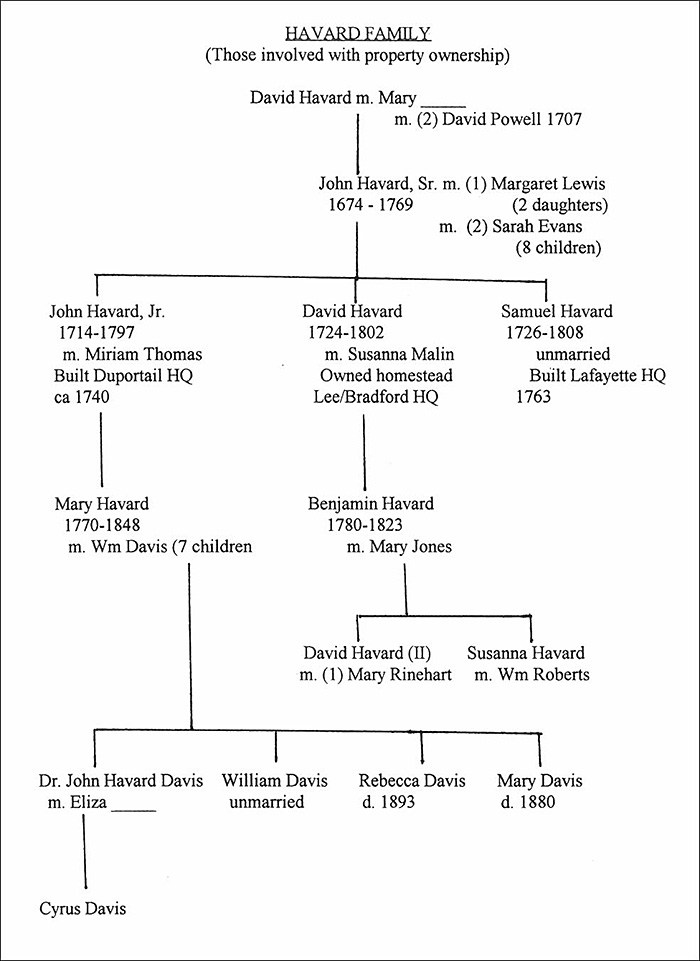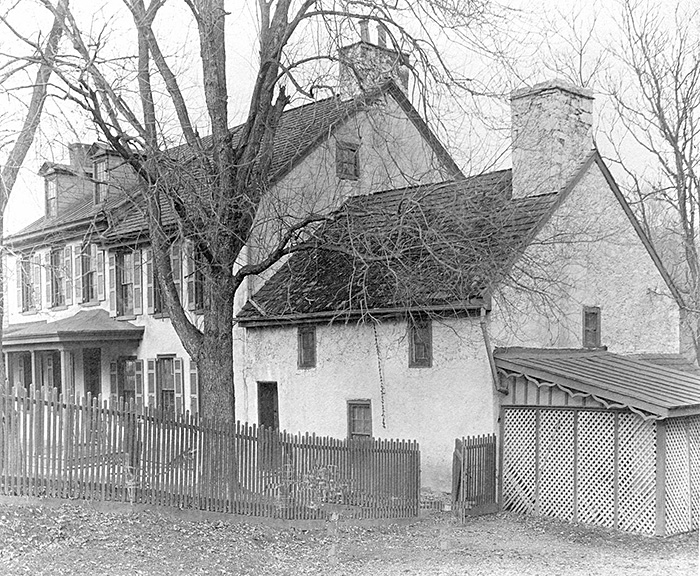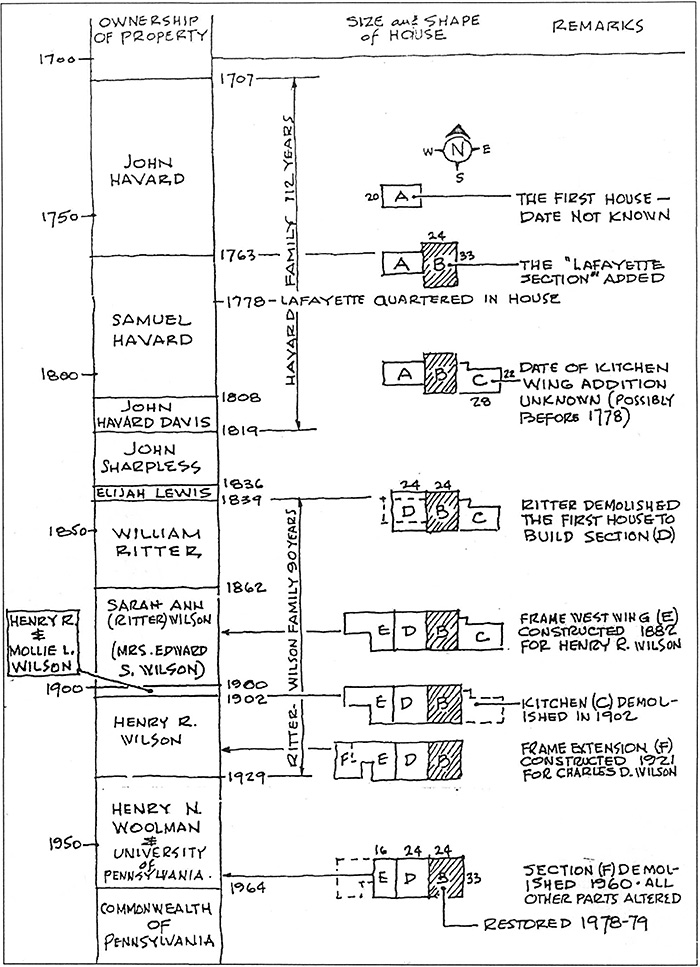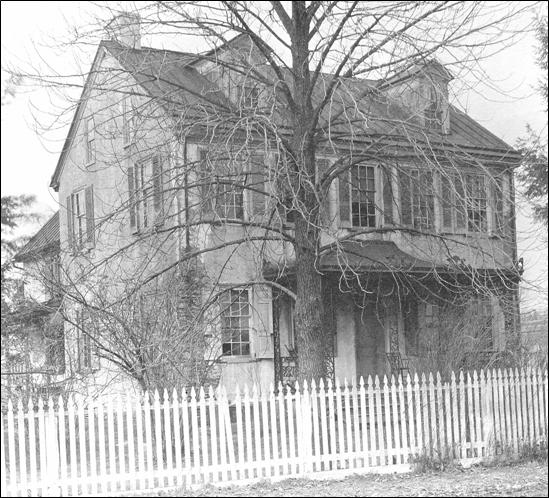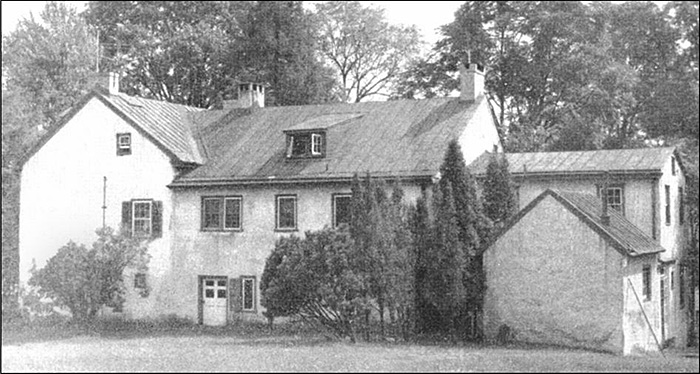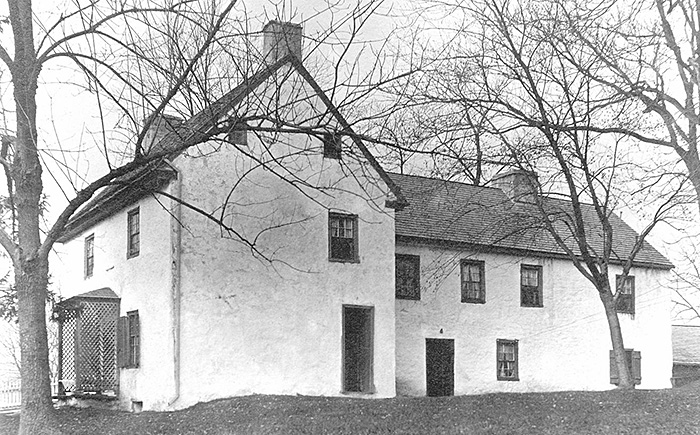|
Home : Quarterly Archives : Volume 41 |
||||||||||||||
Tredyffrin Easttown Historical Society |
||||||||||||||
|
Source: Summer 2004 Volume 41 Number 3, Pages 92–99 THREE PRE-REVOLUTIONARY WAR HOUSES The Tenure of the Havard Family in Tredyffrin Valley
Three local houses played an important role during the Valley Forge encampment when they were used as Lafayette's headquarters, Duportail's headquarters, and the Lee/Bradford headquarters. To put a more human face on these three historic buildings, it is of interest that all three were owned by the Havard family long before and long after the Revolutionary War. The Lafayette headquarters farm was held by the family for 112 years, the Duportail headquarters farm for 196 years, and the Lee/Bradford farm was in their possession for 174 years.
These three farms were part of the Welsh Tract, home of a large group of Welsh Quakers who immigrated from Wales in the latter part of the 17th and early part of the 18th centuries. These Quakers had been sorely persecuted in Wales; fined or jailed for meeting together to worship, for not attending their parish church, or for not taking the oath of allegiance to the King. When William Penn received his land grant in America, the Quakers perceived this would be a haven where they would be free to worship as they chose. These Welsh were not paupers, but self-reliant men with ample means and considerable influence within their communities. Many of them were freeholders of estates. The plans for their migration were thoroughly worked out in a very well-organized manner. In 1681 a group of leaders met with William Penn in Wales and laid out their ideas for settlement in Pennsylvania. They wanted to create blocks of land so neighborhoods could stay together. And they wanted to manage their own affairs within these neighborhoods by creating Baronies whereby a number of justices would be appointed to settle minor disputes and levy taxes. William Penn gave them what they wanted when he issued a Deed of Warranty in 1684 designating 40,000 acres as the Welsh Tract and creating townships of 5,000 acres. The Surveyor General appointed David Powell as the surveyor and agent for the Tract.
The story begins with John Havard, Sr., born in 1674 to David and Mary Havard, who around 1690 at the age of 16, emigrated from Pembrokeshire, Wales with his recently widowed mother. Tax records show John Havard owned 100 acres in Haverford in the early 1700s. In 1706, at the age of 32, he married his first wife, Margaret Lewis. This marriage produced 2 daughters: Mary, born in 1709, and Margaret, born in 1711. In 1707 three events occurred that showed there was a close relationship between John Havard, Sr. and David Powell. On April 16,
1707 David Powell bought 800 acres of a 1500 acre tract from David Meredith. On the same date John Havard, Sr. bought the same 800 acres from David Powell for £200. And on July 16, 1707 David Powell married John Havard, Sr.'s mother, Mary, at the Haverford Meeting. What a buy John Havard, Sr. made. The top soil was sweet and sat on a layer of limestone, there were clear streams abounding in fish, and it was within walking distance of the Schuylkill River which was clear and had large numbers of shad. The Welsh Quakers who settled in this area had all the advantages necessary for prosperous farming. In a presentation at the dedication of the Chimney Picket Post on the western part of this tract, Conrad Wilson made the following remarks: "It was a huge tract, the most fertile tract in the center of the valley." It was bordered by present day Baptist Road on the east, the Paoli exit on Route 202 on the west, Swedesford Road on the south, and Yellow Springs Road on the north. After the death of his first wife, John, Sr. married Sarah Evans and had an additional 8 children. Three of the male children lived to adulthood, John, Jr., David, and Samuel. Their births are listed in the Radnor Meeting records. John Havard, Sr. was on the Haverford Tax List as late as 1722. At some point he moved his family to his tract in Tredyffrin, where the future Lee/Bradford headquarters would be. There is evidence that there were houses on the property as early as 1720. These may have been tenant houses. In 1754, at the age of 79, John Havard, Sr. divested himself of all his ground and distributed his property to his living children. He gave 250 acres to John, Jr., 300 acres to David (this was the home farm), 200 acres to Samuel, and 110 acres to 3 daughters, Ann, Hannah, and Sarah. John Havard, Sr. died in 1769 at the age of 95.
According to an archaeological study by the University of Pennsylvania, the first house built on Samuel's 200 acres was probably built by John Havard, Sr. as a tenant farmer's house in the early 1700s. It had 1-1/2 stories, and was one room deep with two rooms on the second floor. The first addition, on the east side, was built by Samuel Havard in 1763. This was a 2-story stone addition with a cellar and was two rooms deep. Samuel never married and he lived there with two unmarried sisters during the Revolutionary War. The dwelling house is beautifully situated, sitting on a high bluff overlooking Valley Creek.
The south facade of the Samuel Havard house around 1900. The section in the middle is the Lafayette headquarters. The kitchen section on the right with the chimney was demolished in 1902 The 1798 Federal Direct Tax Assessment describes this 200 acre property:
Though the Havards were Quakers, they owned a few slaves. They slowly freed most of them when the Society of Friends demanded it or they would have forfeited their membership. The first United State population census in 1790 lists the Samuel Havard household as consisting of 2 white adult males, 2 free white adult females, 2 people of color, and 1 slave (out of a total of 144 in Tredyffrin Township). The second population census in 1800 shows that Samuel no longer had any slaves. The household consisted of 3 adult white males, 2 adult white females over age 45, 1 white male child under age 10, and 2 other free people. Henry Woodman describes Samuel Havard as a "very wealthy man." Samuel Havard died in 1808 at the age of 82 and left his farm to his great-nephew, Dr. John Havard Davis, grandson of his brother, John Havard, Jr. According to Woodman, "this caused much dissatisfaction among other and nearer relations of his, and after several years and much money were spent in litigation, the will was finally established and the legatee placed in peaceable possession of the property." Priscilla Walker Street writes, "The same nephew inherited with the property $30,000 in silver - as much as 3 men could carry. He soon after relinquished his profession as a physician in which he was fast rising in eminence and entered into a career of land speculation which soon dissipated the property." By the time of the third population census in 1810, the property was occupied by Dr. John Havard Davis. It listed his household as consisting of 1 male over 45, 1 female in her teens, 3 young children, 2 free people of color, and 1 slave. In 1819 John Havard Davis lost this farm to John Sharpless at a Sheriff's sale. It was sold for $20,000. This farm had been in the Havard family for 112 years. Dr. John Havard Davis died in 1821. In 1839, 100 acres, including the buildings, were sold to William Ritter. In 1862 it was inherited by his daughter, Sarah Ritter Wilson, wife of Edward Wilson, and remained in that family for 90 years.
In 1740 John Havard, Jr. had built a house on his father's farm, which would later be known as the Duportail headquarters. In 1754 John Havard, Sr. signed a Deed of Gift for 250 acres to John Havard, Jr., who was 40 years of age at that time. According to an archaeological survey by PennDOT, authorized by the developers of Chesterbrook, the original house was constructed as early as 1720 - probably a tenant farmer's house - and long before John Havard, Jr. took possession of the farm. In 1720 John Havard, Jr. was only 6 years old. John, Jr. married Miriam Thomas and it is likely that they began living in this house, built around 1740, shortly after their marriage. It is believed
Above: The original Duportail house around 1930. Below: The back, or west side, of the Duportail house around 1953 showing the original house in the middle. The section on the right was added around 1810 and the section on the left was enlarged in the 20th century.
that General Louis Duportail, a French engineer who was responsible for the construction of the fortifications at Valley Forge, used their house as his headquarters. The basis for this fact was that the original maps of these fortifications were found hidden in the rafters of the attic of this house during a renovation in 1928. John and Miriam's only child, Mary, was born in 1770 and at the time of the Valley Forge encampment she was 7 years old. She married William Davis who had served as a drummer boy during the encampment. Years after this, William gave information on the encampment that resulted in the Davis-Armstrong-Sparks map of 1833. In 1789 Mary Davis - formerly Havard - acknowledged marrying out of unity. William and Mary Davis had 7 children, one of whom was Dr. John Havard Davis. John Havard, Jr. died around 1797. His will named his grandson, Dr. John Havard Davis, as his heir. The terms of the will stated that before John Havard Davis became 21 years old, his mother, Mary, was empowered to rent out the estate and use the profits for the support of her other children. William and Mary Davis continued to live on the farm. The 1798 Federal Direct Tax Assessment gives William Davis as the owner and occupant of this 229 acre property. It is described as having:
Parts of the old barn on the property dated back to 1792. In 1979, Tredyffrin Township debated whether to raze the old barn which was in a dilapidated condition. The barn was unique because it was "signed" by the stone masons who built it. Richard Webster, from the History Department of what was then West Chester State College, said that to his knowledge it was "… the only 'signed piece' among Pennsylvania bank barns. Inscribed on the interior plaster of the west gable end in large script is "The Federal Barn 1792" and nearby are the longhand inscriptions 'Jonathan Moor his work', 'John H. Moor 1792' … In addition to these there is a date stone in the western gable 'WMD 1792'..... The initials stand for William and Mary Davis, occupants of the farm in 1792, and John Havard, owner of the farm and Mary Davis' father." The barn was not saved. The stone foundations are all that is left. Dr. John Havard Davis married Eliza____, by whom he had a son named Cyrus Davis. Dr. John Havard Davis' debts meant that in 1819 this property was also put on the market. His father, William Davis, bought it in 1820 for $6,400. William Davis died without a will in 1848 and in 1856 his son, William Davis, Jr., was awarded 170 acres. William Davis, Jr. died unmarried and without a will. The entire estate was awarded to his sisters, Rebecca and Mary Davis, and to his nephew, Cyrus Davis. An exchange was made in 1880 between Cyrus and his aunts. His aunts, Rebecca and Mary, received the home farm of 170 acres and Cyrus received 175 acres the sisters had received from an uncle, Samuel Davis. According to a story told by Bob Goshorn, the property that was owned by the Davis sisters was left to two black servants who held spiritual meetings. A nephew challenged the will. Mary Davis died in 1880 and Rebecca died in 1893. In 1894 the executors for the sisters sold their 170 acres to the second David Havard. The farm was sold out of the family in 1903. It had been held by the Havard-Davis family for 196 years.
During the Valley Forge encampment both General Charles Lee and Colonel Thomas Bradford used David Havard's house as their headquarters. General Lee was dismissed from the army after the Battle of Monmouth. He was considered to be a cynical and erratic officer. The first David Havard, 1724-1802, married Susanna Malin in 1774 and they lived on the 300 acre farm deeded to him by his father in 1754. It was the homestead of John Havard, Sr., who died in 1769. At the time of the Valley Forge encampment Susanna and David had two small children. Altogether they had four children, 3 of whom lived to adulthood, Sarah, Benjamin and Jane.
The Lee-Bradford house around 1900. The Shippen Tax of 1760 lists David Havard and his assets:
There is an interesting story connected with this property during the Valley Forge encampment. This story was told by both Henry Woodman and Alden Quimby. There was a Tory spy from Philadelphia who was caught in David Havard's springhouse. The spy was the subject of a search by three groups of soldiers led by Colonel Hamilton and Colonel Dewees. A few days after his capture, he was hanged and later buried in an isolated grave far from the graves of the American soldiers. If true, this must have been a very exciting development in the neighborhood. The 1798 Federal Direct Tax Assessment for David Havard's 300 acres lists the following buildings:
Benjamin Havard, 1780-1823, married Mary Jones and they were the next generation to live on the farm. They had 2 children: the second David Havard, who first married Mary Reinhart and then married Eliza ____?, and Susanna, who married William Roberts. Benjamin's aunts willed their acreage, given to them by their father, to Benjamin, who in turn gave this land to his daughter, Susanna Havard Roberts. The second David Havard and his family lived on the farm until it was sold to A. J. Cassatt in 1881 and comprised part of the 600 acres acquired by Cassatt known as Chesterbrook Farm. This farm had been in the Havard family for 174 years. The house is still standing today on Bradford Road in Chesterbrook. It serves as the clubhouse for the Picket Post Swim and Tennis Club.
"American Officers' Quarters at Valley Forge." Tredyffrin Easttown History Club Quarterly, Vol. 8, No. 2 (April 1954), pages 28-50. Ashmead, Henry Graham. History of Delaware County, Pennsylvania. Philadelphia: L. H. Everts, 1884. Chester County Deed Book B2. Page 84. "Club Again Marks Site of Stone Chimney Picket Post." Tredyffrin Easttown History Club Quarterly, Vol. 18, No. 3 (July 1980), pages 96-100. Cope, Gilbert and Henry Graham Ashmead. Historic Homes and Institutions and Genealogical And Personal Memoirs of Chester and Delaware Counties, Pennsylvania. New York: Lewis Publishing Co., 1904. 2 vols. Documentation and Site Analysis, Duportail House, Chesterbrook, Tredyffrin Township, Chester County, Pa. John D. Milner, Project Director, University of Pennsylvania, Graduate School of Fine Arts, Program in Historic Preservation. Prepared for Duportail House, Inc., 297 Adams Drive, Wayne, PA 19087. May 8, 1992. "Duportail Barn Demolition Stay Extended." Tredyffrin Easttown History Club Quarterly, Vol. 17, No. 4 (October 1979), page 114. Early Church Records of Delaware County. Radnor Monthly Meeting. Futhey, J. Smith and Gilbert Cope. History of Chester County, Pennsylvania with Genealogical and Biographical Sketches. Philadelphia: Louis M. Everts, 1881. Glenn, Thomas Allen. Merion in the Welsh Tract. Norristown, Pa.: Herald Press, 1896. Goshorn, Bob. "A. J. Cassatt's Chesterbrook Farm." Tredyffrin Easttown History Club Quarterly, Vol. 19, No. 4 (October 1981), pages 121-128. Lafayette's Quarters (The Havard-Ritter-Wilson House). John Bruce Dodd, Architect, Cherry Dodd, Associate for the United States Department of the Interior, National Park Service, Mid-Atlantic Region. Valley Forge National Historical Park, 1981. Historic Structure Report. Part 4, Architectural Data. "Old Barn Gets Reprieve." Tredyffrin Easttown History Club Quarterly, Vol. 17, No. 3 (July 1979), page 84. Phase I/II Archaeological Investigations. S. R. 0202, Section 400, Wilson Tract, Tredyffrin Township, Chester County. Prepared by Michael D. Scholl, Principal Investigator and Madeline Scheerer for Pennsylvania Department of Transportation, Engineering District 6-0. King of Prussia, Pa.: Urs. Greiner, Inc., February 1998. Quimby, Alden W. Valley Forge: A Tale. New York: Eaton & Mains, 1906. 1798 Federal Direct Tax Assessment (The Glass Tax). Returns for the Townships of Tredyffrin and East Whiteland of the 4th District (Chester County) in the 2nd Division of the State of Pennsylvania. Schedule A: A Particular List of Dwelling Houses and Outhouses and their Lots worth over $100 on 1st October, 1798. Schedule B: A Particular List of all Lands, Lots, Buildings and Wharves Except Dwelling Houses worth over $100 on 1st October, 1798. Transcribed by Robert L. Ward from the microfilm copy of the original in the National Archives, 1981 Streets, Priscilla Walker. Lewis Walker of Chester Valley and his descendants: with some of the Families with whom they are connected by marriage, 1686-1896. Philadelphia: A.J. Ferris, printer, 1896. United States. Bureau of the Census. First Census of the United States, 1790, Pennsylvania. Washington, D.C.: The National Archives. ________. Second Census of the United States, Made in the Year 1800. Returns for Tredyffrin Township, Chester County, Pennsylvania. Population Schedules. Washington, D.C.: The National Archives. Transcribed by Robert L. Ward, 1981. ________. Third Census of the United States, 1810, Pennsylvania. Washington, D.C.: The National Archives. Woodman, Henry. The History of Valley Forge: with a Biography of the Author and the Author's Father who was a Soldier with Washington at Valley Forge During the Winters of 1777 and 1778. Oaks, Pa.: John U. Francis, 1920. Nancy Pusey's husband is a direct descendant of David Havard. This was presented at the March 28, 2004 meeting of the Tredyffrin Easttown History Club. |
||||||||||||||
